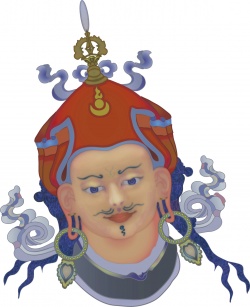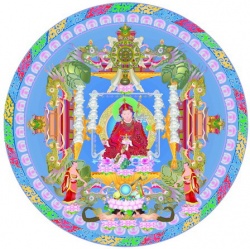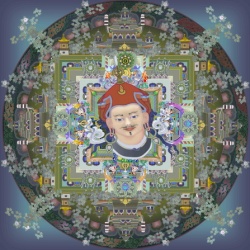The Nyingma Lineage-
The Nyingma lineage is the oldest of the great Tibetan Buddhist traditions. Lineage heads revered by the Nyingma were responsible for bringing Buddhism from India to the “Land of the Snows,” and for the establishment of Buddhism in Tibet.
The Nyingma lineage traces its origin to the Indian master, Guru Padmasambhava, also known as Guru Rinpoche, who came to Tibet in 817 C.E. at the invitation of the Tibetan King, Trisong Detsen (742-797). In the eighth century, while the great Buddhist traditions were flourishing in India, King Trisong Detsen invited the great Abbot Shantarakshita to establish Buddhism in Tibet. The King worked with Shantarakshita in establishing Buddhism, but they soon faced hindrances to their work. At Shantarakshita’s suggestion, the King of Tibet invited Padmasambhava to Tibet, requesting him to pacify the negative and obstructing forces. Through his compassion and wisdom, Padmasambhava overcame these obstacles, and genuine Buddhism was successfully transplanted in Tibet .
Together with the great bodhisattva, Abbot Shantarakshita, Padmasambhava built the renowned Samye monastery (in Southern Tibet), which became a principal center of learning, where most of the Sanskrit texts and literature from India were first translated into Tibetan. Under the guidance of Padmasambhava, Shantarakshita, and the Dharma King Trisong Detsen, the teachings of Buddha Shakyamuni, as well as the commentaries of the Indian masters of Nalanda University and other places were fully translated into Tibetan at Samye.
Masters of Vajrayana
Guru Rinpoche was a Vajrayana master, and he taught widely from the highest classes of tantra, the textual vehicles of the Vajrayana. In particular, he transmitted these Vajrayana teachings to his twenty-five principal disciples. These first Tibetan masters became renowned for their spiritual accomplishments. The continuous, unbroken transmission from Guru Rinpoche through these principal disciples to their own disciples and so forth is called Kama, the oral transmission lineage.
Padmasambhava also hid hundreds of scriptures, images and ritual articles throughout Tibet. These items became known as “Treasures,” and were concealed in many different ways. At the same time, Padmasambhava left precise instructions on how to discover and reveal these treasures for the benefit of future generations. Since that time, over a hundred masters have appeared who revealed these Treasures and taught them to their disciples, in this way continuing the lineage of Padmasambhava. The master who reveals such treasure is known as the terton , or “treasure revealer.” This transmission from Guru Rinpoche through the tertons is called the Terma, the revealed treasure lineage. These lineages of revealed teachings include the Dzogchen, or Great Completion, teachings taught by Garab Dorje, Shri Simha, Padmasambhava, Jnanasutra, and Vimalamitra, and are known today in Tibet as the Nyingma lineage.
Lines Of Transmission
The Nyingma lineage identifies three specific lines of transmission of the Vajrayana teachings of the tantras:
the Thought Lineage of the Buddhas;
the Symbolic Lineage of the Awareness Holders or Vidhyadharas; and
the Human Ear-whispered Lineage.
The lineage transmission that was carried by Padmasambhava originated with the teachings of Samantabhadra, Vajrasattva and the Prince Prahevajra or Garab Dorje, who transmitted the Dzogchen Atiyoga teachings. The latter lived in India a few centuries after the parinirvana (death) of the Buddha. Garab Dorje transmitted those teachings to Manjusrimitra and from him to Shrisimha, and then to the Indian-born teachers, Padmasambhava, Jnanasutra, and Vimalamitra. They, together with the Tibetan-born teacher Vairochana, received the transmission of this lineage directly from the aforementioned lineage holders, and in turn transmitted and brought the lineage and teachings to Tibet, thus commencing in Tibet the lineage which continues to the present day.
The Nine Yana Path
Teachings of the Nyingma lineage classify the entire Buddhist teachings into Nine Yanas or Vehicles.
The Three Common Vehicles:
1) Shravaka Yana,
2) Pratyekabuddha Yana, and
3) the Bodhisattva Yana;
the Three Outer Tantras of:
4) Kriya Tantra,
5) Upa or Charya Tantra, and
6) Yoga Tantra;
finally, the Three Innermost Tantras:
7) Mahayoga,
8) the Anuyoga, and
9) the Atiyoga.
The first six of these nine yanas or vehicles are common to all schools of Tibetan Buddhism, whereas the last three are unique to the Nyingma lineage.
Nyingma Institutions In Tibet And India
Initially, the lineage traditions of the Nyingma was based less on institutional structures than on individual lineage transmission, but the Nyingma lineage became more institutionalized later in its history. Nyingma teachers began building great Nyingma monastic centers in the 15th century. The most renowned centers are the Six Great Seats of the Nyingma lineage, which consist of:
Central Tibet:
1) Mindrol Ling, founded in 1676;
2) Dorje Drak, founded in 1632;
Eastern Tibet:
3) Dzogchen, founded in 1685;
4) Shechen, founded in 1735;
Lower Eastern Tibet:
5) Kathok, founded in 1159;
6) Palyul, founded in 1665.



